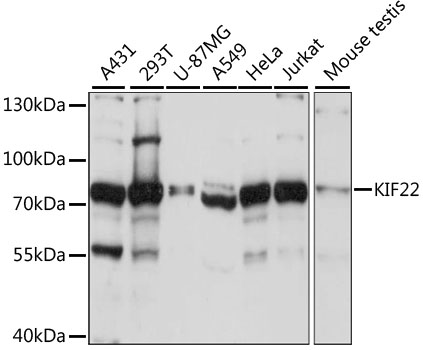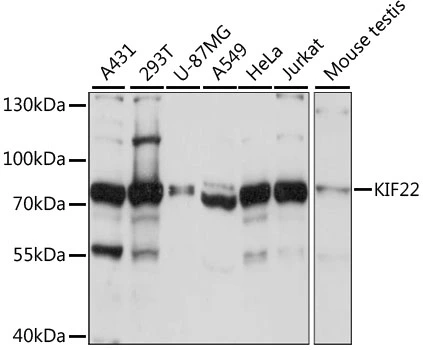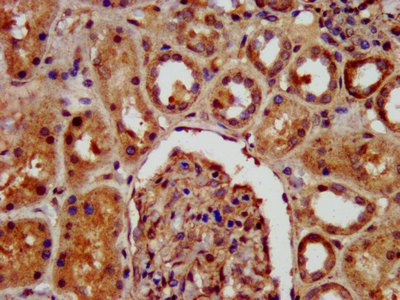KIF22 antibody [N3C2], Internal
GTX112357
ApplicationsImmunoFluorescence, Western Blot, ImmunoCytoChemistry, ImmunoHistoChemistry, ImmunoHistoChemistry Paraffin
Product group Antibodies
TargetKIF22
Overview
- SupplierGeneTex
- Product NameKIF22 antibody [N3C2], Internal
- Delivery Days Customer9
- Application Supplier NoteWB: 1:500-1:3000. ICC/IF: 1:100-1:1000. IHC-P: 1:100-1:1000. *Optimal dilutions/concentrations should be determined by the researcher.Not tested in other applications.
- ApplicationsImmunoFluorescence, Western Blot, ImmunoCytoChemistry, ImmunoHistoChemistry, ImmunoHistoChemistry Paraffin
- CertificationResearch Use Only
- ClonalityPolyclonal
- Concentration1 mg/ml
- ConjugateUnconjugated
- Gene ID3835
- Target nameKIF22
- Target descriptionkinesin family member 22
- Target synonymsA-328A3.2, KID, KNSL4, OBP, OBP-1, OBP-2, SEMDJL2, kinesin-like protein KIF22, kinesin-like DNA-binding protein pseudogene, kinesin-like protein 4, oriP binding protein, origin of plasmid DNA replication-binding protein
- HostRabbit
- IsotypeIgG
- Protein IDQ14807
- Protein NameKinesin-like protein KIF22
- Scientific DescriptionThe protein encoded by this gene is a member of kinesin-like protein family. This family of proteins are microtubule-dependent molecular motors that transport organelles within cells and move chromosomes during cell division. The C-terminal half of this protein has been shown to bind DNA. Studies with the Xenopus homolog suggests its essential role in metaphase chromosome alignment and maintenance. [provided by RefSeq]
- Storage Instruction-20°C or -80°C,2°C to 8°C
- UNSPSC12352203
References
- Thompson AF, Blackburn PR, Arons NS, et al. Pathogenic mutations in the chromokinesin KIF22 disrupt anaphase chromosome segregation. Elife. 2022,11. doi: 10.7554/eLife.78653Read this paper
- Pike R, Ortiz-Zapater E, Lumicisi B, et al. KIF22 coordinates CAR and EGFR dynamics to promote cancer cell proliferation. Sci Signal. 2018,11(515). doi: 10.1126/scisignal.aaq1060Read this paper







![ELISA analysis of antigen using GTX60506 KID antibody [5F3]. Red : Control antigen 100ng Purple : Antigen 10ng Green : Antigen 50ng Blue : Antigen 100ng](https://www.genetex.com/upload/website/prouct_img/normal/GTX60506/GTX60506_20170912_ELISA_w_23061123_875.webp)
![ELISA analysis of antigen using GTX60508 KID antibody [1E3]. Red : Control antigen 100ng Purple : Antigen 10ng Green : Antigen 50ng Blue : Antigen 100ng](https://www.genetex.com/upload/website/prouct_img/normal/GTX60508/GTX60508_20170912_ELISA_w_23061123_498.webp)